- Aaron Jones gains some competition: Jones spent his career in a two-back committee, and his new competition comes from Jordan Mason.
- The Minnesota Vikings improve their offensive line: Left tackle Christian Darrisaw is healthy, while the team brought in three new interior linemen.
- Subscribe to PFF+: Get access to player grades, PFF Premium Stats, fantasy football rankings, all of the PFF fantasy draft research tools and more!
Estimated Reading Time: 5 minutes

PFF’s Fantasy Football Player Profile series delivers the most in-depth fantasy football analysis available for the 2025 season.
Using PFF’s exclusive data, we evaluate player performance, competition for touches and how teammates and coaching staffs
Last updated: 7:15 a.m. Tuesday, May 27
Player performance
Aaron Jones spent the first seven seasons of his career with the Green Bay Packers. He consistently graded 79.0 or better in the run game while he was with the Packers, leading to a 93.7 rushing grade over those seven years. That was the third-highest for running backs, only behind Nick Chubb and Derrick Henry.
Volume and injuries were a constant concern throughout Jones’ career. He never exceeded 15 rushing attempts per game and missed time in five of his seven seasons. While he only graded well, not great, as a receiver, he received 2.8 receptions per game, which helped his fantasy value. His touchdown totals were generally high while playing in an offense with Aaron Rodgers. Jones finished at RB3 and RB6 in 2019 and 2020 when Jones was at his peak and Rodgers was playing at an MVP level. He finished at RB17 or better every year from 2018 to 2022.
Injuries were a big problem for Jones in 2023. A hamstring injury cost him three of the first five games of the season. He has three mediocre games playing at least 50% of his team's offensive snaps in the middle of the season before an MCL injury cost him another three weeks. He was finally healthy at the end of December, and he finished the year with five-straight 100-yard rushing performances, including the playoffs.
The Packers made changes at running back in the 2024 offseason, signing Josh Jacobs, drafting MarShawn Lloyd and cutting Jones. He found his way to the division rival Minnesota Vikings. He played a career-high 62.7% of the Vikings' offensive snaps, despite being limited in a few games throughout the season due to various injuries. However, he never missed a game. He set a career-high in rushing attempts per game and was just as involved in the passing game as ever. However, his efficiency in the run game continued to take a noticeable dip, as his first-down rate took a significant hit and his EPA on run downs went from positive to negative. Jones gained at least five yards on 39.4% of his carries over the last five seasons which is the best among all running backs, and that rate only dipped to 36.7% last season, so Jones' fall has mostly been from a great running back to an average one, rather than someone who shouldn’t be on the field anymore. He finished 20th in fantasy points per game among running backs.
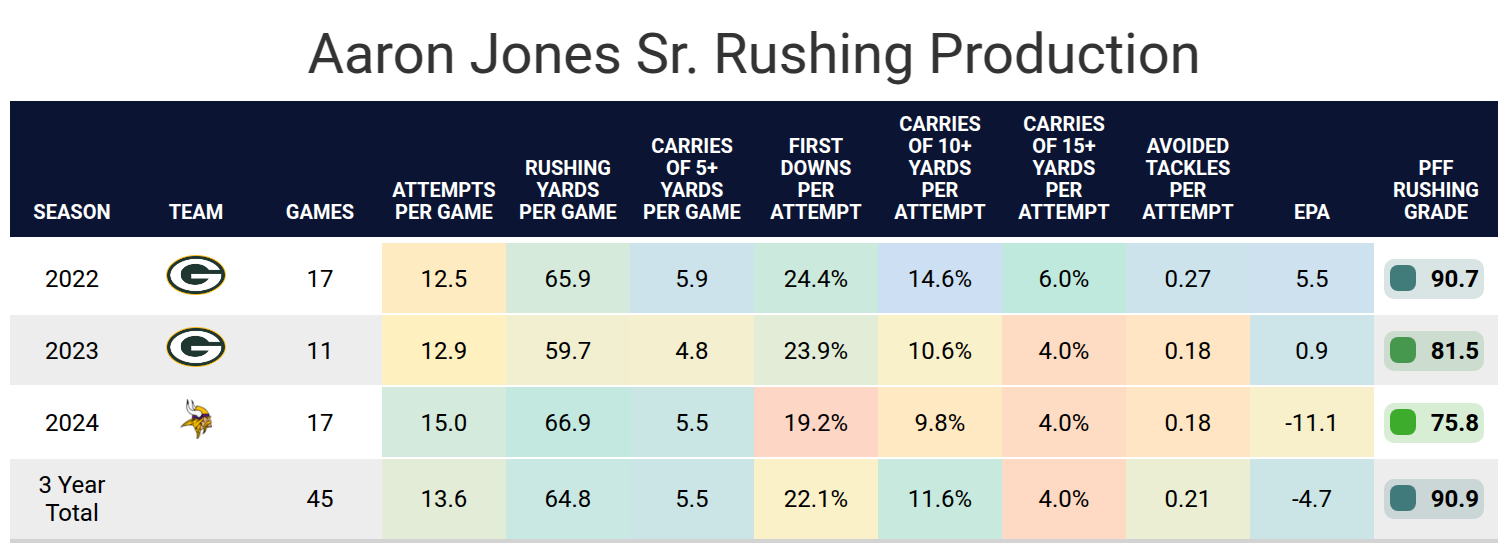
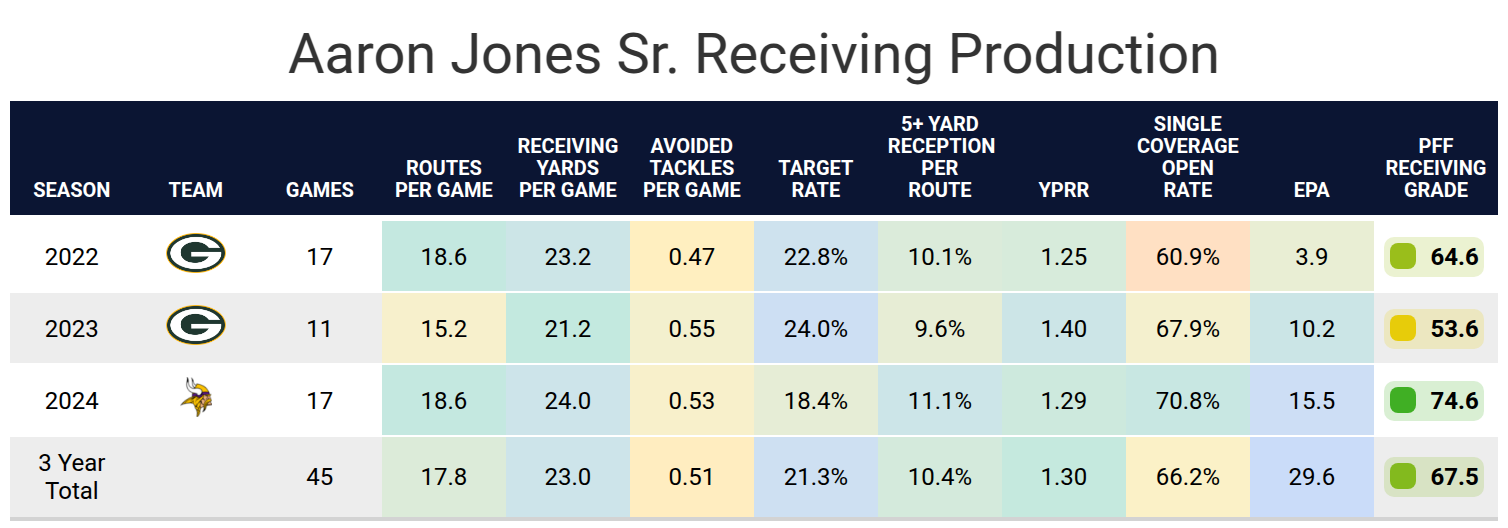

Projected role
Ty Chandler started the 2024 season as the primary backup, and then the Vikings traded for Cam Akers to be the backup over the rest of the season. The Vikings often used fullback C.J. Ham on third downs. The further the distance, the more likely Ham was on the field.
Minnesota traded with the San Francisco 49ers to upgrade their backup spot with Jordan Mason, who spent his first two seasons as a highly effective backup to Christian McCaffrey. He spent the first seven weeks as the 49ers‘ primary running back with McCaffrey injured. He was RB10 over his time as a starter. Mason started dealing with a shoulder injury, and then McCaffrey returned. Once McCaffrey was injured again, Mason suffered an ankle injury in the same game, costing him the rest of his season.
Jones and Mason’s rushing grades have been within one point of each other, regardless of whether you look at last season, the previous two seasons or the last three seasons. Given Jones’ age and decline in recent seasons, it wouldn’t be surprising if Mason is the better rusher this year. This could mean more Mason rushing attempts or much closer to a 50-50 split. However, Mason has never had a game with more than two receptions, while Jones averaged three receptions per game last season. We should expect Jones to play more while retaining most, if not all, of the passing game work. Jones may play even more and earn more opportunities this season, while running the ball less often.
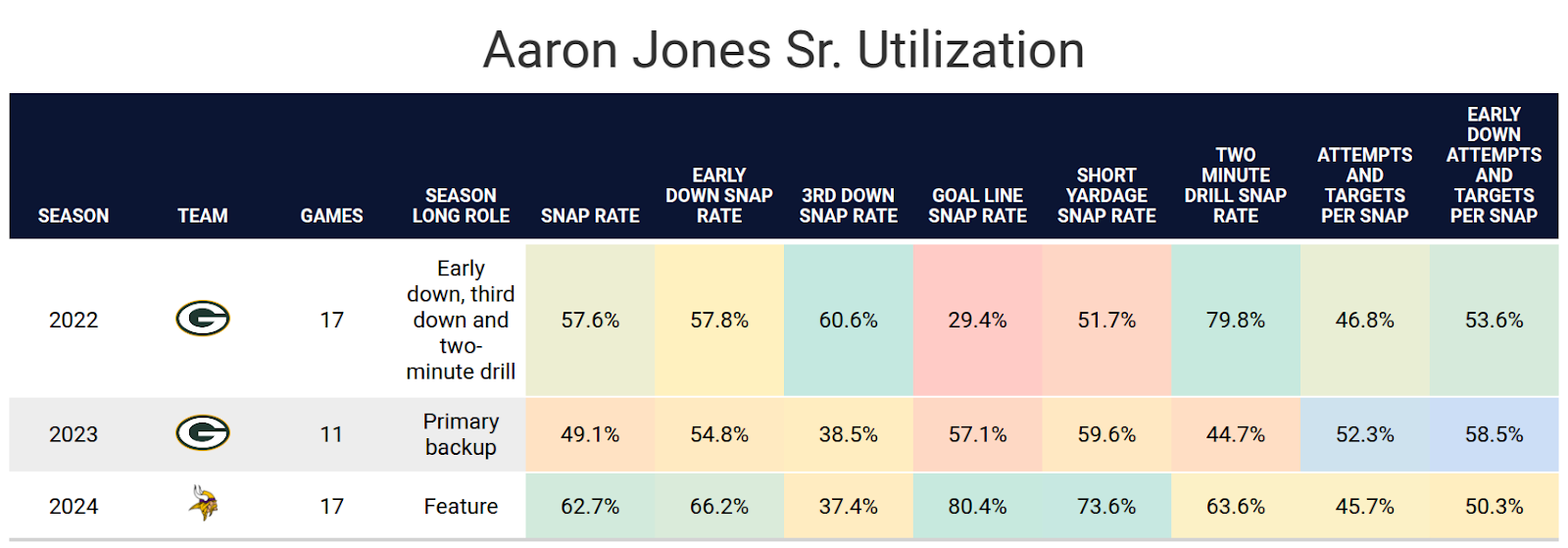
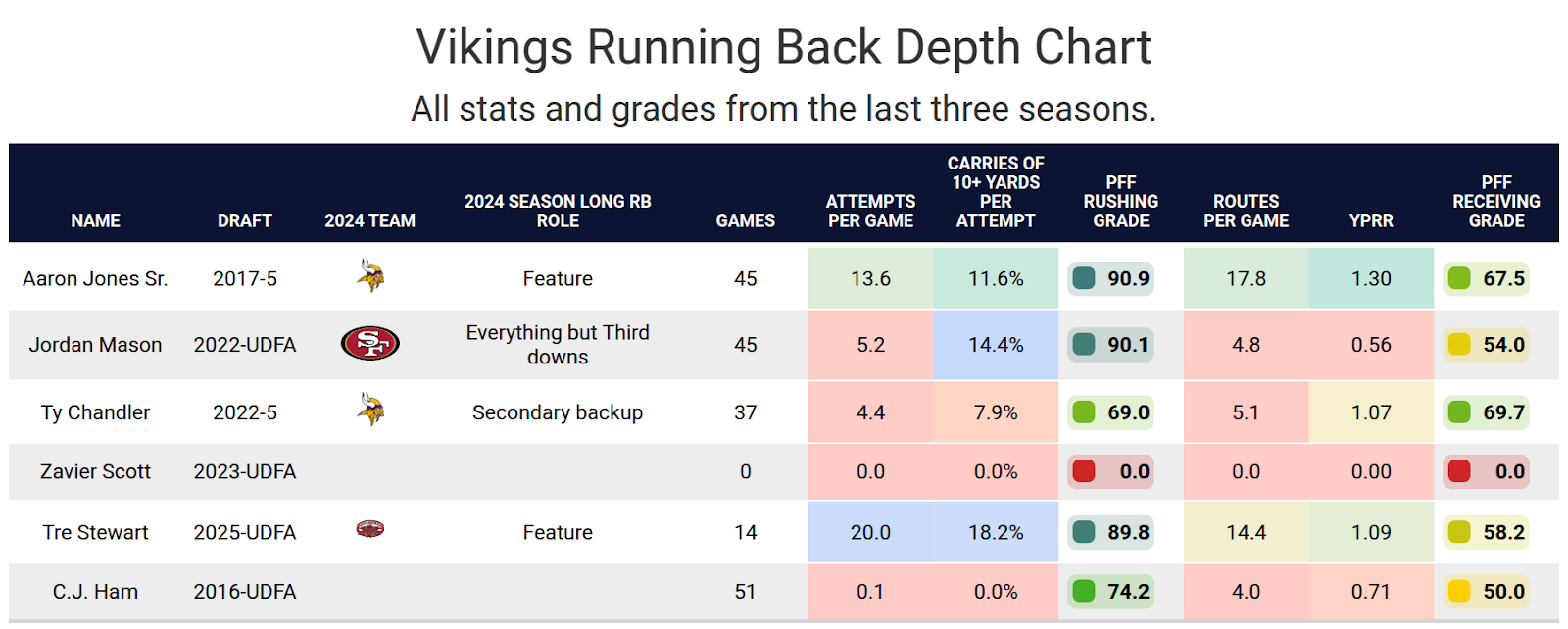
Impact of teammates
Aaron Jones will be in his second season under Kevin O’Connell, whose offenses have been consistently low in run rate over expected, regardless of the quarterback, with a low running back target rate, irrespective of the running back. This generally isn’t great for Jones. O'Connell's running back rotation has changed from one week to another, causing Jones' snap rate to fluctuate significantly. For example, from Weeks 15-17, Jones' snap rate went from 61.0% to 81.8% to 51.4%, despite all being Vikings victories. This makes it harder to know when to trust starting Jones.
The Vikings had a relatively average offensive line last season, which should be notably better this season, depending on how quickly the line can gain chemistry. Their best run blocker, Christian Darrisaw, missed over half of last season. The Vikings' guards were underwhelming last season, so they upgraded with Will Fries in one spot. It’s hard to predict exactly how well a rookie offensive lineman will do in their first season, but first-round rookie Donovan Jackson should be an upgrade at the left guard spot. It wouldn’t be surprising if Jones’ rate stats bounce back from last season, thanks to the improvements to the line.
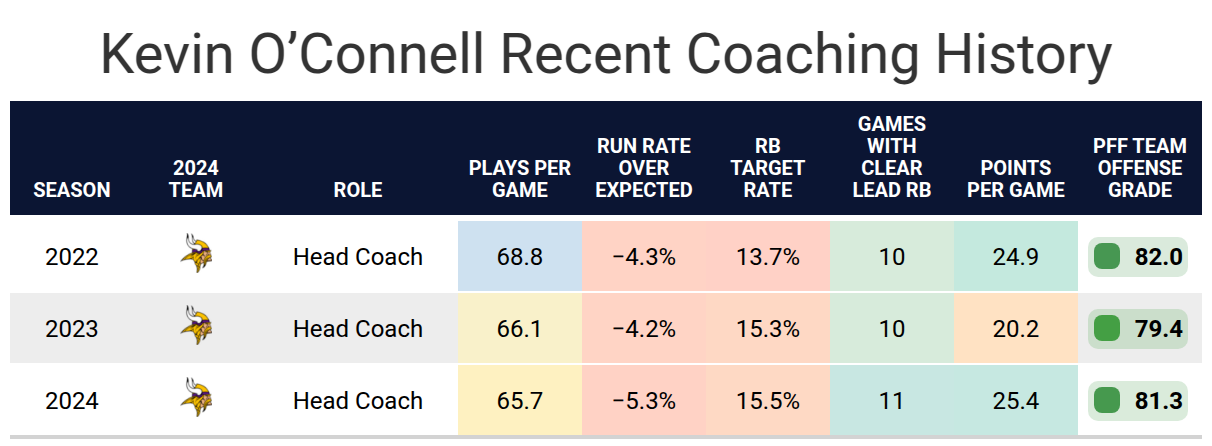

Bottom line
Jones’ days as a top-15 fantasy running back are likely behind him, as he’s now 30 years old and has significant competition for touches. As long as he can keep half of the rushing work and the receiving duties, he should remain someone worth starting in fantasy leagues more often than not.

Footnotes
- Statistics in tables and charts were chosen based on their ability to predict future fantasy performance on a per-game or per-opportunity basis or to describe the player relative to others at the same position.
- “Opportunities” are defined as passing dropbacks, rushing attempts and routes run as a receiver.
- Numbers are provided either by season or based on the past three years. For rookies, only college statistics are included. For non-rookies, only NFL statistics are considered, regardless of whether they played in college within the previous three years.
- As college competition is easier than NFL competition, most rookies are likely to see a decline from their historical numbers.
- Only FBS data is considered for college players and comparisons.
- Kneel-downs are removed from rushing data to provide cleaner quarterback rushing rate statistics.
- The table colors in this article range from blue (indicating good/high) to red (indicating bad/low).
- All percentiles and color codings compare the given player to others with a high sample of opportunities. Generally, the cutoff is one-third of the possible opportunities in the sample. If a player does not meet the threshold, they are still included in the comparison, though their results may appear better or worse than expected due to the smaller, less predictive sample size.
- Information on utilization classifications and their importance can be found here for running backs, wide receivers and tight ends.



 © 2025 PFF - all rights reserved.
© 2025 PFF - all rights reserved.